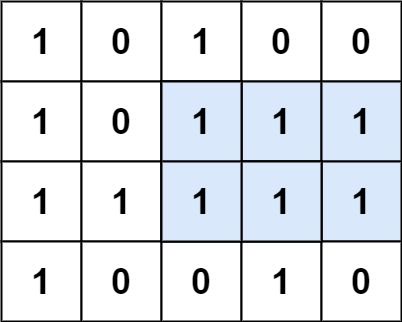# 最大矩形
给定一个仅包含 0 和 1 、大小为 rows x cols 的二维二进制矩阵,找出只包含 1 的最大矩形,并返回其面积。
示例 1:

输入:matrix = [["1","0","1","0","0"],["1","0","1","1","1"],["1","1","1","1","1"],["1","0","0","1","0"]]
输出:6
解释:最大矩形如上图所示。
示例 2:
输入:matrix = []
输出:0
示例 3:
输入:matrix = [["0"]]
输出:0
示例 4:
输入:matrix = [["1"]]
输出:1
示例 5:
输入:matrix = [["0","0"]]
输出:0
提示:
rows == matrix.lengthcols == matrix[0].length0 <= row, cols <= 200matrix[i][j] 为 '0' 或 '1'
以下错误的选项是?
## aop
### before
```c
#include
using namespace std;
```
### after
```c
int main()
{
Solution sol;
vector> matrix = {{'1', '0', '1', '0', '0'},
{'1', '0', '1', '1', '1'},
{'1', '1', '1', '1', '1'},
{'1', '0', '0', '1', '0'}};
int res;
res = sol.maximalRectangle(matrix);
cout << res << endl;
return 0;
}
```
## 答案
```c
class Solution
{
public:
int largestRectangleArea(vector &heights)
{
stack h;
heights.push_back(0);
int ans = 0, hsize = heights.size();
for (int i = 0; i < hsize; i++)
{
while (!h.empty() && heights[h.top()] > heights[i])
{
int top = h.top();
h.pop();
ans = max(ans, heights[top] * (h.empty() ? i : (i - h.top())));
}
h.push(i);
}
return ans;
}
int maximalRectangle(vector> &matrix)
{
if (matrix.empty())
return 0;
int n = matrix.size(), m = matrix[0].size(), ans = 0;
vector> num(n, vector(m, 0));
for (int j = 0; j < m; j++)
{
num[0][j] = (matrix[0][j] == '0') ? 0 : 1;
for (int i = 1; i < n; i++)
num[i][j] = (matrix[i][j] == '0') ? 0 : num[i - 1][j] + 1;
}
for (int i = 0; i < n; i++)
{
int area = largestRectangleArea(num[i]);
ans = max(ans, area);
}
return ans;
}
};
```
## 选项
### A
```c
class Solution
{
public:
int maximalRectangle(vector> &matrix)
{
int res = 0;
vector height;
for (int i = 0; i < matrix.size(); ++i)
{
height.resize(matrix[i].size());
for (int j = 0; j < matrix[i].size(); ++j)
{
height[j] = matrix[i][j] == '0' ? 0 : (1 + height[j]);
}
res = max(res, largestRectangleArea(height));
}
return res;
}
int largestRectangleArea(vector &heights)
{
if (heights.empty())
return 0;
stack st;
heights.push_back(0);
int res0 = 0;
for (int i = 0; i < heights.size(); i++)
{
while (!st.empty() && heights[i] < heights[st.top()])
{
int curHeight = heights[st.top()];
st.pop();
int width = st.empty() ? i : i - st.top() - 1;
if (width * curHeight > res0)
res0 = width * curHeight;
}
st.push(i);
}
return res0;
}
};
```
### B
```c
class Solution
{
public:
int maximalRectangle(vector> &matrix)
{
if (matrix.size() == 0)
{
return 0;
}
int m = matrix.size();
int n = matrix[0].size();
int left[n];
int right[n];
int height[n];
memset(right, n, sizeof(right));
memset(left, n, sizeof(left));
memset(height, n, sizeof(height));
int maxarea = 0;
for (int i = 0; i < m; ++i)
{
int cur_left = 0, cur_right = n;
for (int j = 0; j < n; ++j)
{
if (matrix[i][j] == '1')
{
height[j]++;
}
else
{
height[j] = 0;
}
}
for (int j = 0; j < n; ++j)
{
if (matrix[i][j] == '1')
{
left[j] = max(left[j], cur_left);
}
else
{
left[j] = 0, cur_left = j + 1;
}
}
for (int j = n - 1; j >= 0; --j)
{
if (matrix[i][j] == '1')
{
right[j] = min(right[j], cur_right);
}
else
{
right[j] = n;
cur_right = j;
}
}
for (int j = 0; j < n; ++j)
{
maxarea = max(maxarea, (right[j] - left[j]) * height[j]);
}
}
return maxarea;
}
};
```
### C
```c
class Solution
{
public:
int maximalRectangle(vector> &matrix)
{
if (matrix.size() == 0)
{
return 0;
}
int maxarea = 0;
int dp[matrix.size()][matrix[0].size()];
memset(dp, 0, sizeof(dp));
for (int i = 0; i < matrix.size(); ++i)
{
for (int j = 0; j < matrix[0].size(); ++j)
{
if (matrix[i][j] == '1')
{
dp[i][j] = j == 0 ? 1 : dp[i][j - 1] + 1;
int width = dp[i][j];
for (int k = i; k >= 0; k--)
{
width = min(width, dp[k][j]);
maxarea = max(maxarea, width * (i - k + 1));
}
}
}
}
return maxarea;
}
};
```
